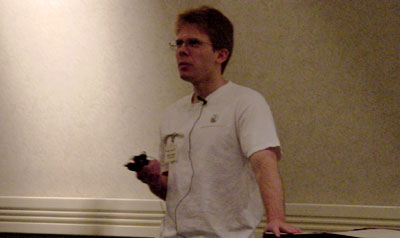The fifth stage of the RLV grieving process<< page 2: the view from Scottsdale New challenges, new barriersAt this year’s Space Access conference, like those in previous years, there have been discussions about the challenges companies face to develop their vehicles, including the financial and regulatory barriers. In the past, there have been panels were people discussed the problems companies faced raising money as well as the obstacles to legally flying their vehicles. This year, however, those issues seemed less critical. Many companies developing vehicles have either found funding (including self-funding, in the case of Armadillo), or have had modest, ongoing success raising money. Regulation is also less of a concern than in past, based in large part on the cooperative nature of the relationship between industry and the FAA. (See “RLV regulation: licensing vs. certification”, April 28, 2003). However, there are still concerns the industry faces. One of them, surprisingly, is credibility. The “giggle factor” associated with some ventures, if not the industry in general, has not gone away even today. “It has turned out that our biggest problem right now has been companies getting liability jitters and backing out on us,” said Carmack. He believes that may be because Armadillo—with its whimsical name and logo—has been very open about what the company has been doing, publishing accounts of what they have done, including what fails, on its web site. “It has become a significant issue.”
This has, in particular, caused Armadillo problems obtaining propellant. Armadillo’s engines use concentrated (90 percent) hydrogen peroxide, but the two major industrial producers of the chemical have so far declined to sell to Armadillo, citing liability concerns. This has also become an issue for other companies interested in using peroxide. Carmack said that Armadillo is exploring several options, ranging from funding a startup company that can create concentrated peroxide to scrapping peroxide altogether in favor of alternative, more readily accessible propellants. The peroxide shortage has forced Armadillo to scale back or delay engine and flight tests until a solution can be worked out. Another concern that has yet to be fully addressed by the industry is human factors, or the effects of suborbital spaceflight on the human body. John Jurist, a biophysicist with the consulting firm CRM Inc., said he was asked by XCOR to look into the radiation exposure people for those flying the Xerus. He found that the upper limit to the radiation exposure on a Xerus flight would be 5-6 microsieverts, or one-tenth the radiation from a chest x-ray. “Someone could ride the Xerus every half hour for a working lifetime and not reach the NRC [Nuclear Regulatory Commission] lifetime limits,” he said. While Jurist believes that radiation exposure as well as other aspects of suborbital flight, such as the g-forces of launch, can be handled by most people, there is a concern that these issues could become a significant hurdle if other agencies get involved and impose their regulations on this field. “The time is now to get involved in the regulatory process,” said Jurist. “It’s going to take a couple of years to get this all sorted out for suborbital flight.” Handicapping the X PrizeSpace Access ’03 took place a week after Burt Rutan’s company, Scaled Composites, rolled out its X Prize vehicle, SpaceShipOne. While no representatives of Scaled attended the conference, there was a considerable amount of interest in, and speculation about, the vehicle and Rutan’s plans for it. Many people see Rutan as the leading competitor for the X Prize, with the potential to win it by late this year or early next year.
Diamandis acknowledged that Rutan is seen as the frontrunner, but that the prize is far from being won yet. He noted that, by 1927, Richard Byrd was considered the frontrunner for the Orteig Prize for crossing the Atlantic, but his plane crashed on takeoff; the previously-unknown Charles Lindbergh won the prize instead. “It is still a race,” Diamandis said, “and I believe there are still two or three teams that can give Burt a run for his money.” That view was shared by Armadillo’s Carmack. “We’re not intimidated by Burt Rutan,” he said. “We still think we’re solidly in the running.” He noted that Rutan “has many times the experience and resources to put into this, but, I think he’s made the job many times as hard.” “I suspect we will see some exciting things happening this year,” Carmack added. Statements like that may be the surest sign that the RLV industry has put the loss of the LEO launch market behind it and is moving on to tackle new markets and new challenges. Home |
|
